settings
children
With Famly since
What are mud kitchens?
Let's start from the top. If you're just discovering the concept (and joy!) of mud kitchens, welcome. In a nutshell, mud kitchens are child-scaled kitchens, designed for imaginative messy play using mud instead of real ingredients.
The very simplest mud kitchens offer children some counter space, a back board and a stovetop, but there's lots of room for creativity. Some might have working taps with running water, to incorporate easy water play. Others might have a chalk board for inventing recipes, or hooks so your muddy chefs can hang utensils.
You can buy a pre-made, standalone mud kitchen online, or you can build your own out of scrap wood.
What's the point of mud kitchens in early education?
Mud kitchens offer hours of messy play, open ended play and creative fun for children — and they've got some big developmental benefits, too. Messy mud play has been shown to have a host of different benefits, both physical and emotional. The fresh air, and the mud itself can help children develop a robust immune system, while the sensory play and interacting with nature and other children can inspire young imaginations.
Playing in mud kitchens can promote both teamwork and independent learning, and there are benefits in motor skill development, mood regulation, and more. But the most important benefit is also the simplest: Mud kitchens are a whole lot of fun.
To reap all the rewards and boost the fun factor, you might try out these activities and upgrades in your own early years mud kitchen.
10 ideas to cook up in your early years mud kitchens
1. Mud kitchen make-believe: Theme day
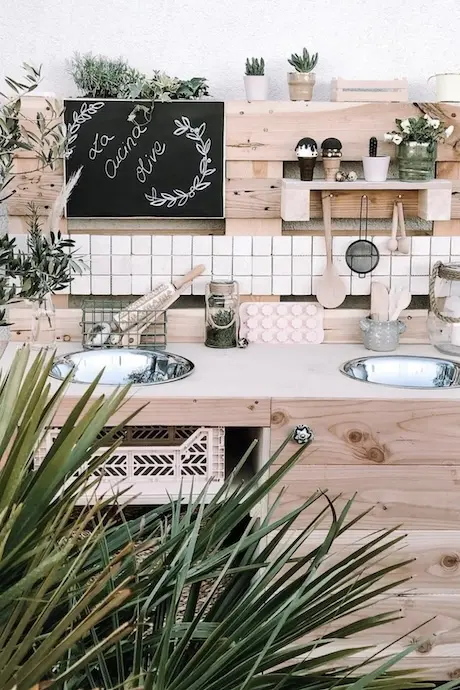
The early years mud kitchen activity: While a lot of make-believe already goes on in a mud kitchen, you can add to the fantasy by encouraging children to create a theme for each day's play.
Source: Real Homes
- Mud kitchen
- Aprons or coveralls
- A bit of imagination!
How to do it: A great way to come up with new themes for each day of mud kitchen play is to think about what the children have been learning about lately, at home and at school. For example, if you've recently visited a science museum, then making the mud kitchen a laboratory can help the children explore the new concepts they've learned. If they've been learning about a different country at school, then you could show them traditional meals from that country and help them recreate them in their mud kitchen. This can be a good way to stimulate children's creative thinking, as they learn to apply new concepts they've learned into their mud kitchens.
2. Mud kitchen café

The early years mud kitchen activity: Help your children transform their mud kitchen into a mud café where they serve up imaginary dishes to their friends. This one's great for whole groups of children to work together in imaginative play.
Source: The Crafting Chicks
What you need:
- Mud kitchen
- Baking trays and utensils (Cake pans, muffin trays, cupcake molds, measuring cups, mixing spoons, and other utensils can often be found at garage sales and thrift stores)
- Menus
- Café sign
- Tables and chairs
- Optional: Laminator and laminating sleeves for added durability
How to do it: With just a few simple tweaks, the mud kitchen can be transformed into a mud café. First, help the children come up with a name for their café. Then, help them design a simple menu with three or four items like mud lattes, mud cupcakes, mud milkshakes, and rock cakes. The menu can be created on your computer in programs like Microsoft Word or Photoshop, or if you'd like to keep it simple, you can help the children hand-draw their menu. A simple blackboard is a great solution for the children to use as their café signage. Place some tables and chairs around the mud kitchen, lay out your menus, and the café is ready to open. Then it's up to the children to run the business as they see fit.
3. Begin a garden for your mud kitchens
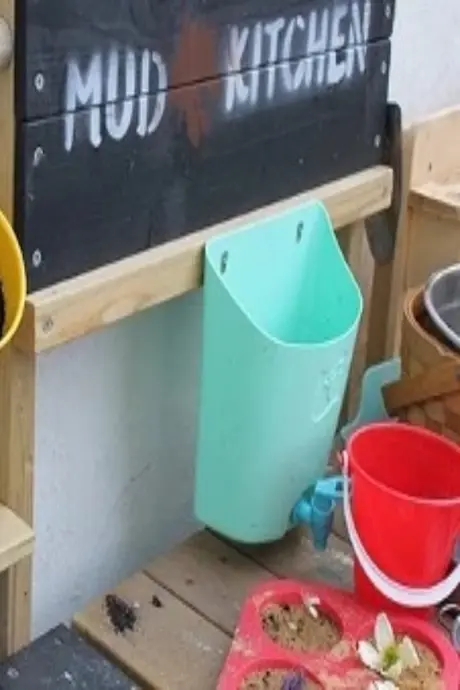
The early years mud kitchen activity: Add a garden extension to your child's mud kitchen to nurture their relationship with the natural world and start teaching little ones about gardening, sustainability, and food production.

Source: BBC Good Food
What you need:
- Flower pots
- Seeds
- Child-sized watering can
- Soil
How to do it: If you don't already have a stock of planters and flower pots, then start this activity with a fun trip to your local nursery or hardware store. Help the children select some planters, pots, seeds (herbs and bright colored flowers are ideal), soil, and a child-sized watering can. As you go, take the opportunity to teach them about where food comes from and encourage them to have a strong connection with nature. You can get creative with how you display the pots and planters. This is also a wonderful way to bond with children as you teach them how to care for the plants.
4. Fantastic food painting project
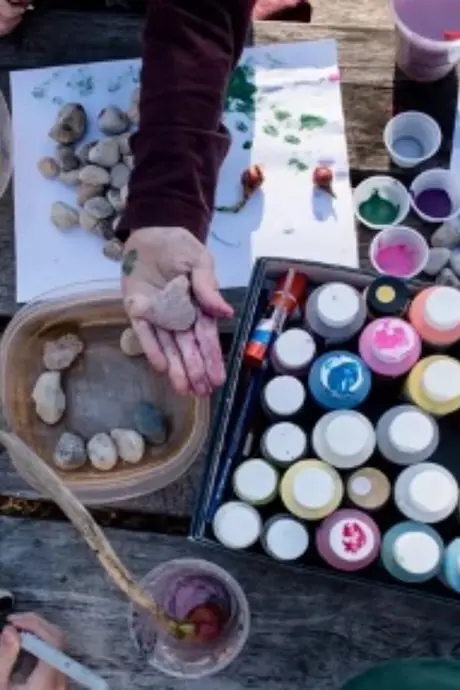
The early years mud kitchen activity: Mud isn't the only ingredient you can use to make “food” in the mud kitchen. Painting rocks and pebbles of all sizes is a fun project that will then provide all sorts of “meals” and decorations for future play.
Source: Gardening Etc
What you need:
- Rocks and pebbles
- Paint
- Paintbrushes and other painting tools
- A container of water for the paintbrushes
How to do it: Create some space at an outdoor table, provide plenty of paints, and let the children go wild painting a variety of rocks and pebbles. Small, colorful pebbles are great as decorations on mud pies. Larger rocks of different shapes may lend themselves to being different foods. For example, large, rounded rocks could be fried eggs or burgers, while wedge-shaped rocks could be pizza or watermelon slices.
5.Fresh air foraging for new recipes

The early years mud kitchen activity: Create recipe cards the children can use to forage for ingredients, so they can whip up some new dishes in their mud kitchen. Older children will especially love the free, exploratory element of the hunt for new ingredients.
Source:This Tiny Blue House
- Printed recipes
- A laminator to protect them from the mud (alternatively, you can take them to a print shop to be laminated)
- Dry-erase markers
- Collecting baskets, buckets, or tins
How to do it: Start by creating recipe cards for different dishes like flower cakes or mud pies. Each one should have a list of ingredients that can be found in the garden. Once these have been printed and laminated, you can use them as a reading exercise with the children. Then, it's time to get foraging and then get busy in the mud kitchen. If you have a recipe blackboard in the mud kitchen, you can also write up a recipe of the day for the children to forage for and create. This is a great exercise in teaching children to count and measure — after all, putting too many leaves and flowers in the sand muffin recipe would ruin the texture.
6.Making muddy muffins

The early years mud kitchen activity: In this project, you can help children make their own mud, showing them how different ratios of water and dirt will create a different consistency. Then, you and your muddy chefs can whip up some tasty mud muffins.
Source: Gardening Etc
What you need:
- Mud kitchen
- Muffin tray
- Extra bowls, pots or pans for mixing the mud
- Dirt and water
- Flowers, leaves, seeds, pebbles. and other decorations
How to do it: Set out the different buckets or containers, and mix different ratios of dirt and water in each. Allow the children to mix the mud with their hands so they get a feel for the different textures. Ask them questions to help them learn. How thick does the mud need to be to create a nice mounded muffin? What happens when it's too runny? What happens when it's too thick? Allow them to play with adding more dirt to some buckets and more water to others to create new consistencies. They can then let their imaginations run wild when it comes to creating toppings for each muffin.
7. Mixing up some fizzy mud
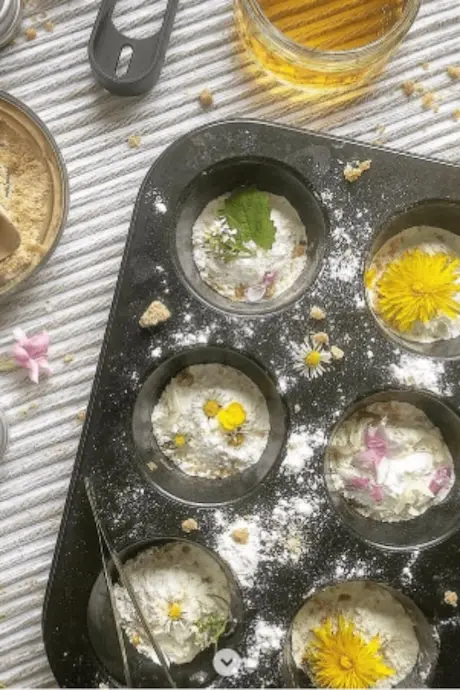
The early years mud kitchen activity: Up your mud game and teach your children about science and sustainability with this glittery fizzy mud experiment.
Source: Thimble and Twig
- Mud
- Bicarbonate of Soda (baking soda)
- Eco-safe glitter
- Vinegar
How to do it: If you thought playing with mud was fun, wait until you try fizzy mud. This activity is often as mesmerizing for the adults as it is for the children. All you need to do is mix some bicarbonate of soda with the mud. Track down eco-glitter to add a bit of pizzazz, and be sure to explain the environmental impact of traditional glitter to the children. Traditional glitter is a form of microplastic that can make its way into waterways and the ocean, affecting the growth of aquatic plants and filling the bellies of aquatic creatures. This will get them thinking about sustainability and caring for the environment at an early age. To get the fizz going, add vinegar to the mix and let the science experiment unfold.
8. Potion making in the garden
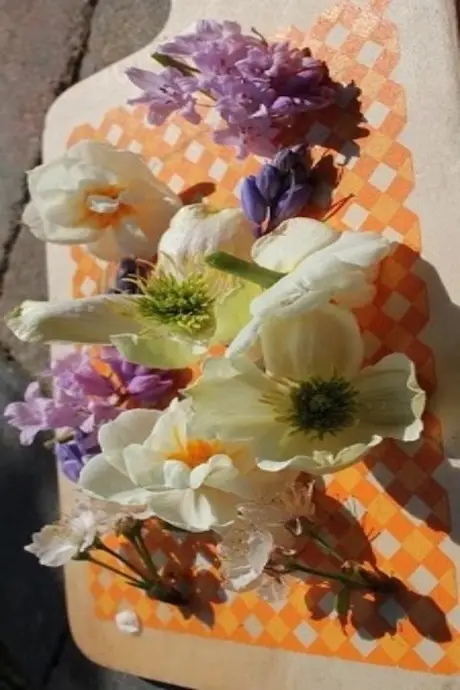
The early years mud kitchen activity: Bring a little magic into the mud kitchen by helping the children select herbs and flowers to make their own potions.
Source: BBC Good Food
What you need:
- Fragrant flowers and herbs
- Pretty bottles that can be used as potion bottles (these can often be found in craft stores, thrift stores, and discount stores)
- Funnels
- Water
- Labels
- A garden or other area for gathering ingredients
How to do it: All you need for your potion-making class are mixing bowls, pretty potion bottles, water, and some fragrant herbs and flower petals. Start in the garden, and give the children as much freedom as possible in selecting their ingredients and choosing which ones to blend. Have them stir it all up in the mixing bowl, and then use a funnel to transfer it into a potion bottle. Leave the bottles to infuse, and in the meantime, decorate and label them. Each morning, the children can check on their potions to see how they're developing. Once the potions are ready, they can be labeled and put on display in the mud kitchen or given as gifts to friends and family members.
9. A sculptor's workshop
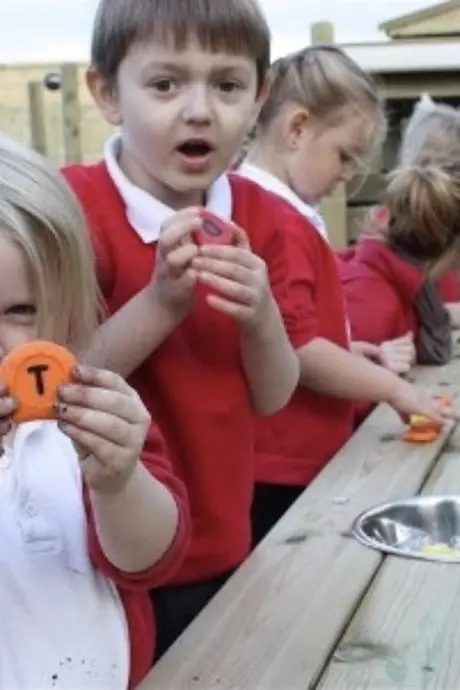
The early years mud kitchen activity: Use the mud kitchen as a modeling studio by bringing clay and homemade playdough into the mix. The children can mold and decorate, creating works of art while developing their motor skills.
Source: Pentagon Play
What you need:
- Mud kitchen
- Clay and/or playdough
- Eco-glitter, pebbles, seeds, and other decorative elements
How to do it: Mud kitchens may have been made for mud, but that doesn't mean you can't bring other materials into the mix. You can either provide store-bought clay or find a recipe for homemade playdough online and use the mud kitchen to create it. Then, give the children the freedom to play with these materials and create their own masterpieces. This is a great form of sensory play, particularly if you introduce things like pebbles, sand, and seeds that will change the texture of the sculpting material.
10. Create a bird café

The early years mud kitchen activity: Encourage a connection with nature, bring more birds into your backyard, and add a new dimension to the mud kitchen by using it as a way to connect with the natural world.
Source: Gardening Etc
What you need:
- Mud kitchen
- A variety of bird seed
- Suet or vegetable fat
- Oatmeal
- Crushed peanuts
- Bird feeders
How to do it: Start by sitting down with the children to research the different birds that live in your area and what they like to eat. Use this as your shopping list for picking out seeds and other goodies the birds like to eat. Then help the children create feasts for your feathered friends. You can create fat balls by mixing together the seeds, oatmeal, crushed peanuts, and suet or vegetable fat. Bird feeders can be bought at the local hardware store, or you can find a DIY cheatsheet online and make it another fun project to work on with the children.
The big ideas
Please note: here at Famly we love sharing creative activities for you to try with the children at your setting, but you know them best. Take the time to consider adaptions you might need to make so these activities are accessible and developmentally appropriate for the children you work with. Just as you ordinarily would, conduct risk assessments for your children and your setting before undertaking new activities, and ensure you and your staff are following your own health and safety guidelines.
Get 1000s of free EY activities
Want over 7,000 activities? See them in a free 14-day trial. Filter to target learning areas, age groups and topics, and get inspired.
Get started









